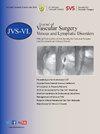Early experience with diclofenac topical gel for moderate to severe postablation phlebitis
IF 2.8
2区 医学
Q2 PERIPHERAL VASCULAR DISEASE
Journal of vascular surgery. Venous and lymphatic disorders
Pub Date : 2025-01-01
DOI:10.1016/j.jvsv.2024.101994
引用次数: 0
Abstract
Objective
Oral (PO) nonsteroidal anti-inflammatory drugs (NSAIDs) are commonly used to treat phlebitis and thrombus extension postendovenous ablation. Few studies have evaluated diclofenac topical gel for treating postablation phlebitis. This study assesses diclofenac 1% topical gel as a first-line treatment for patients with moderate to severe phlebitis after ablation.
Methods
From December 2021 to March 2024, a retrospective cohort study was performed to identify patients who developed postablation phlebitis and were treated with either diclofenac topical gel (with or without PO NSAIDs) vs PO NSAIDs alone. All patients were evaluated with a numeric pain rating scale (NPRS, 0-10) at four time intervals (1, 7, 14, and 30 days) after initiating treatment.
Results
Overall, 45 patients were included in the study, with 38 in the diclofenac ± PO NSAIDs group (9 males and 29 females) and 7 in the PO NSAIDs alone group (all females). NPRS scores showed similar pain reduction trends at all time intervals. Topical diclofenac gel was noninferior to PO treatments and resulted in partial to complete relief in most patients at 30 days. At the 30-day follow-up interview, 57% of patients preferred the diclofenac topical gel owing to its ease of use and immediate local pain reduction.
Conclusions
Patients with moderate to severe postablation phlebitis respond well to diclofenac topical gel with or without PO NSAIDs. Moreover, patients often had significant pain relief without additional need for PO NSAIDs. Longitudinal studies are needed to support the use of diclofenac topical gel for postablation phlebitis.
双氯芬酸局部凝胶治疗中度至重度消融术后静脉炎的早期经验。
目的:口服(PO)非甾体抗炎药(NSAIDs)常用于治疗静脉内消融术后的静脉炎和血栓扩展。很少有研究对双氯芬酸局部凝胶治疗消融术后静脉炎进行评估。本研究评估了 1% (%) 双氯芬酸局部凝胶作为消融术后中度至重度静脉炎患者的一线治疗方法:方法:从 2021 年 12 月到 2024 年 3 月,我们进行了一项回顾性队列研究,以确定发生消融术后静脉炎并接受双氯芬酸局部凝胶(联合或不联合 PO 非甾体抗炎药)治疗的患者与仅接受 PO 非甾体抗炎药治疗的患者。所有患者在开始治疗后的四个时间间隔(1、7、14 和 30 天)都接受了疼痛评分量表(NPRS,0-10)的评估:共有 45 名患者参与了研究,其中 38 人属于双氯芬酸 +/- PO 非甾体抗炎药组(9 名男性和 29 名女性),7 人属于单用 PO 非甾体抗炎药组(均为女性)。在所有时间间隔内,NPRS 评分都显示出相似的疼痛减轻趋势。外用双氯芬酸凝胶的疗效并不比口服药物差,大多数患者的疼痛在 30 天后得到部分或完全缓解。在30天的随访中,57%的患者更喜欢使用双氯芬酸局部凝胶,因为它使用方便,能立即减轻局部疼痛:结论:中重度消融术后静脉炎患者对双氯芬酸局部凝胶联合或不联合 PO 非甾体抗炎药反应良好。此外,患者往往能明显缓解疼痛,而无需额外服用 PO 非甾体抗炎药。需要进行纵向研究,以支持使用双氯芬酸局部凝胶治疗剥脱术后静脉炎。
本文章由计算机程序翻译,如有差异,请以英文原文为准。
求助全文
约1分钟内获得全文
求助全文
来源期刊

Journal of vascular surgery. Venous and lymphatic disorders
SURGERYPERIPHERAL VASCULAR DISEASE&n-PERIPHERAL VASCULAR DISEASE
CiteScore
6.30
自引率
18.80%
发文量
328
审稿时长
71 days
期刊介绍:
Journal of Vascular Surgery: Venous and Lymphatic Disorders is one of a series of specialist journals launched by the Journal of Vascular Surgery. It aims to be the premier international Journal of medical, endovascular and surgical management of venous and lymphatic disorders. It publishes high quality clinical, research, case reports, techniques, and practice manuscripts related to all aspects of venous and lymphatic disorders, including malformations and wound care, with an emphasis on the practicing clinician. The journal seeks to provide novel and timely information to vascular surgeons, interventionalists, phlebologists, wound care specialists, and allied health professionals who treat patients presenting with vascular and lymphatic disorders. As the official publication of The Society for Vascular Surgery and the American Venous Forum, the Journal will publish, after peer review, selected papers presented at the annual meeting of these organizations and affiliated vascular societies, as well as original articles from members and non-members.
 求助内容:
求助内容: 应助结果提醒方式:
应助结果提醒方式:


